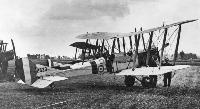Фотографии
-
Much of Ted Busk’s experimental research into inherent stability in aircraft was undertaken on modified Royal Aircraft Factory B.E.2s. Here Lt S.C. Wingfield Smith of the Royal Aircraft Factory brings a B.E.2a in for a landing during experiments with modified “fin struts” circa 1913-14.
Самолёты на фотографии: RAF B.E.2 - Великобритания - 1912
-
Lieutenant Wingfield Smith poses in a B.E.2a with fin struts in January 1913. Improvements to the fuselage decking, revised flying controls and a new fuel system resulted in the B.E.2b; this was itself modified based on the results of trials with the R.E.1s into the B.E.2c, which incorporated staggered wings and ailerons.
Самолёты на фотографии: RAF B.E.2 - Великобритания - 1912
-
Регистрационный номер: 601 The machine in which Busk was killed, B.E.2c No 601, seen here before the accident sporting two “floating fins”, each of 6ft2 (0-6m2), atop the upper wing centre section.
Самолёты на фотографии: RAF B.E.2 - Великобритания - 1912
-
Регистрационный номер: 2633, 4172 By the spring of 1915 B.E.2cs had become standard equipment for first-line Royal Flying Corps squadrons on the Western Front. These Daimler-built 90 h.p. Royal Aircraft Factory 1a-engined B.E.2cs were photographed in France in 1915 while serving with No 16 Sqn, which had received its first examples in February of that year.
Самолёты на фотографии: RAF B.E.2c/B.E.2d - Великобритания - 1914
-
Регистрационный номер: 607 The R.E.1 was a development of the B.E.2 designed for research into an inherently stable reconnaissance aircraft, and differed from the latter in being a single-bay biplane with staggered wings. Only two R.E.1s were built, both initially fitted with wing-warping controls. This is the first, No 607, after having been fitted with ailerons.
Самолёты на фотографии: RAF R.E.1 - Великобритания - 1913
-
Регистрационный номер: 608 Busk at the controls of the second R.E.1, No 608, fitted with warping wings and four fixed fins on the upper wing, which were used for his stability trials. After Busk’s death, Col Mervyn O’Gorman, Superintendent of the Royal Aircraft Factory, recalled that Busk “did the most magnificent things without announcing any intention and without applauding audience. With his hair blown about by a hatless flight, he would walk into my office and report the success of an experiment. He forgot that it was brilliant, or it did not occur to him ...”
Самолёты на фотографии: RAF R.E.1 - Великобритания - 1913
Статьи
- -
- A.Griffith - America's Ramjagers
- A.Roberts - Death of a Visionary: Edward T. Busk and "Stability Jane"
- A.Zeitler - "we wanted to do somethind challenging..."
- B.Archer - Party Time!
- D.Stringer - Non-Skeds! /The Story of America's Supplemental Airlines/ (1)
- F.Merriam - Up for the Cup! /Echoes from Dawn Skies/ (4)
- G.Alegi - Alitalia's Fab Four
- J.Forsgren - Holf the Front Page! The ASJA Viking
- J.Franzi - Perfect Third? /An eye for detail/
- J.Watson - "It was a Jaguar D-type on steroids"
- P.Davidson - Off the Beaten Track...
- P.Jarrett - Lost & Found
- P.Vabre - Lost without trace?
- R.Gardner - A Jaunt Over Germany
- R.Pegram - Folland's Forgotten Monoplanes (1)





